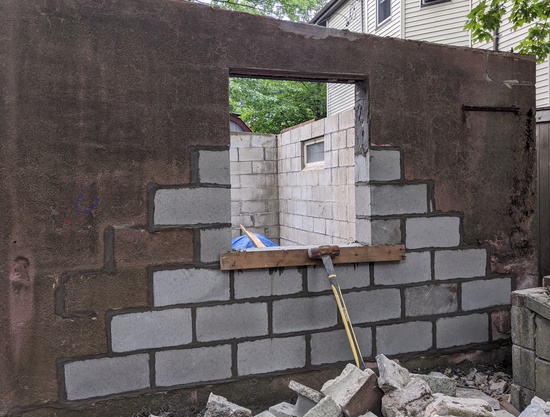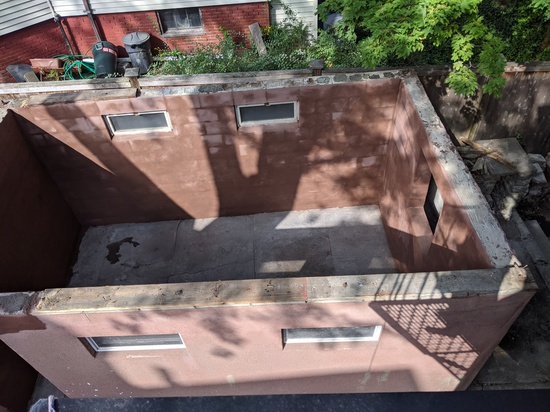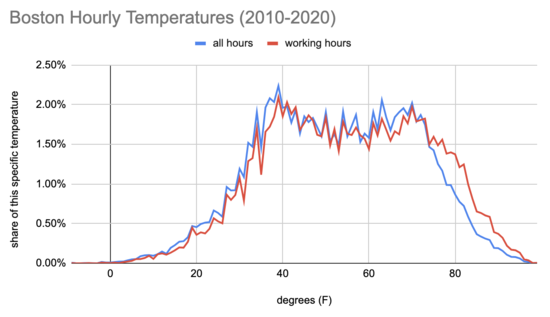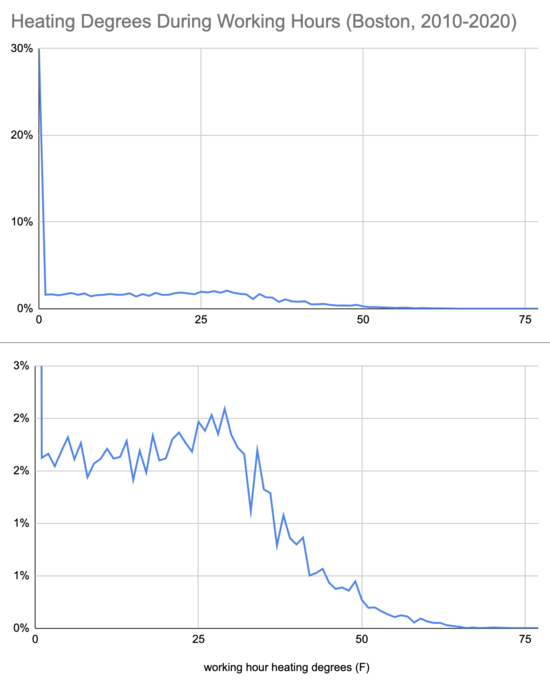A few months ago I wrote about trying to decide what to do with our shed. It turns out that not only is our property too small for a tiny house ("backyard cottage"), the only reason we're able to have the shed where it is it's because it is grandfathered in. The shed turned out to have solid footings, so we decided to have it repaired.
I hired a mason to redo the cinderblock and a carpenter to replace the roof. The mason has finished, and I'm waiting for the carpenter to start:
When the carpenter is done, we'll have a weathertight structure, but we still need to figure out what we want to do with the inside. One thing I'm trying to figure out is how much insulation makes sense. As a detached building with electricity, we would probably use resistive heat, which is relatively expensive (~$0.21/kWh).
The structure is:
| Walls | 335 sqft |
| Roof | 145 sqft |
| Floor | 145 sqft |
| Door | 18 sqft |
| Side windows | 12 sqft |
| End window | 8 sqft |
Most of the structure is exposed to air, which is generally much colder than the ground, so I'm going to ignore the floor.
Heat loss is proportional to area and temperature difference, and also varies by material. This per-material factor is called the U-factor (heat / area-degree). When dealing with conductive heat loss, which is the main kind of loss I expect us to see here, people generally use its reciprocal, the R-value. Attempts at estimating the R-values of the shell components, in F*sqft*hr/BTU:
| Walls | 8" cinderblock | 1.11 |
| Roof | 3/4 plywood sheathing, asphault shingles | 0.94 + 0.44 |
| Door | solid wood | 2.17 |
| Side windows | single pane | 0.91 |
| End windows | double pane | 3.4 |
This gives me:
335 sqft / 1.11 F*sqft*hr/BTU + 145 sqft / 1.38 F*sqft*hr/BTU + 18 sqft / 2.17 F*sqft*hr/BTU + 12 sqft / 0.91 F*sqft*hr/BTU + 8 sqft / 3.4 F*sqft*hr/BTU = 430 BTU / F*hr
How many heating degree hours (F*h) should we count? If it is 50F outside for one hour and I want it to be 70F inside, that's 20F*h. What is it over the course of a year?
The standard approach is to look up heating degree days for your location. This is a standard number computed for many places, and assumes you heat your building to 65F. Per NationalGrid, over the last 30 years Boston has averaged 6,521 heating degree-days. We're not planning to live in the shed, though, and instead we would probably use it as a home office. So we only care about heating degree hours that fall during working hours. There aren't standard tables for this, as far as I can find, but we can calculate them from NOAA's Local Climatological Data summaries.
LCD offers hourly temperatures for each weather station as CSV, and then you can do your own processing. I wrote a script (github) that assumes we heat it to 68F, turning on the heat at 7am (since it cooled off at night and needs time to warm up) until 5pm.
It does tend to be warmer during the day than overall, though it's more of a difference in summer:
During working hours, 30% of the time we need no heat at all. The rest of the time we typically need a modest amount of heat, and occasionally it is very cold and we need a lot:
On average, over all the working hours including the ones when the heat is off, we need 7.09 heating degrees. If someone used it full time (9hr/d x 250d/y) that's 2,250hr/y and 16,000 heating degree hours.
Going back to our calculation earlier, we can now estimate how much heat we need:
430 BTU / F*hr * 16,000 F*hr * 0.00029 kWh / BTU = 1990 kWh
At $0.21/kWh, this is $420/y in heating. What would it be with insulation?
Let's imagine we use R-15 insulation for the walls and R-30 for the ceiling, plus 1/2" drywall (R-0.45). Where does that leave us?
335 sqft / (1.11+15+0.45) F*sqft*hr/BTU + 145 sqft / (1.38+30+0.45) F*sqft*hr/BTU + 18 sqft / 2.17 F*sqft*hr/BTU + 12 sqft / 0.91 F*sqft*hr/BTU + 8 sqft / 3.4 F*sqft*hr/BTU = 49 BTU / F*hr 49 BTU / F*hr * 16,000 F*hr * 0.00029 kWh / BTU * $0.21 / kWh = $48/y
It looks like it would save about $375/y, and bring heating costs down to a very reasonable $48/y. This isn't perfect because it ignores the effect of thermal mass (so too high) and heat loss through the floor (so too low), but I think it's probably in the right range.
How much would that much insulation cost? Fiberglass R-15 is about $0.70/sqft and R-30 is about $0.91/sqft, add $0.37/sqft for the drywall and another $0.37/sqft for the wall studs, and ignore my installation time (since this is something I would enjoy doing), and this is ~$668. Payback of 1.5y for something that should last decades, and would make the space much nicer than having concrete walls. Seems worth it!



